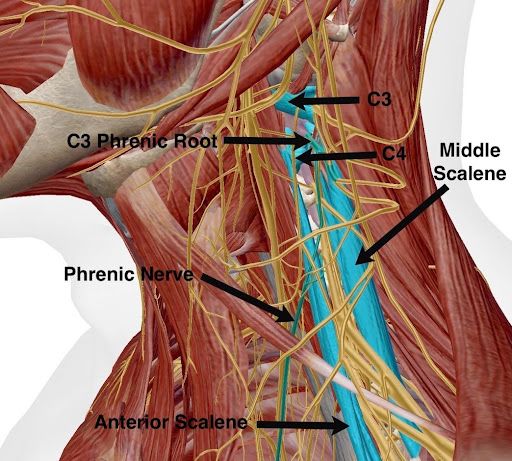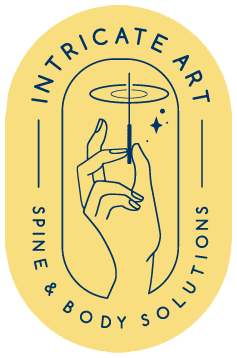
Dry Needling & Joint Manipulation to Treat & Resolve Hiccups by Inducing Autonomic Nervous System Homeostasis
Dr. Andrew Huberman, who I love and highly recommend, recently spoke about hiccups and how to resolve them, along with some awesome information on how to regulate the autonomic nervous system via sympathetic autonomic depression with certain breathing techniques.

However, this is not the best long-term way to resolve hiccups. The best way is thoughtful dry needling combined with joint manipulation. Dr. Huberman’s technique works via amplification of the underlying mechanism causing hiccups. Sympathetic autonomic nervous system hyperactivity. Forcing excessive contraction of the diaphragm elevates sympathetics. Excessive, conscious contraction of muscle is a sympathetic-dominant neurophysiologic process. Like hiccups. Again, and this is not super easy to grasp, this breathing technique works by turning up the part of the nervous system that is already turned up too high, the sympathetics, but the extra stimulation, acutely, in the immediate short-term, exhausts the innervated structures, the diaphragm and phrenic nerve, in this case, leading to temporary relaxation.
The best way to induce prolonged resolution of hiccups is to directly target the autonomic nervous system dysregulation that is causing them in the first place. In Physical-Therapy-Land, the most powerful way we have to accomplish this is removing as much tissue pathology throughout the body, while at the same time specifically targeting the parasympathetic portion of the autonomic nervous system.
Video: Dr. Huberman on Hiccups
Why is this?
- Remember, the autonomic nervous system is like a seesaw, which should be relatively neutral, on average. If one side goes up, the other side goes down.
- If the sympathetic side goes up too much for too long, as it does in the overwhelming majority of people, it can get stuck, at which point the autonomic nervous system loses its ability to self-regulate to homeostasis.
- The simple process of living typically causes elevated sympathetic activity. Mental and physical stress, strain, trauma, and pain all elevate sympathetic activity.
- The brain and body keep score, even if you are not consciously aware of them doing so. Any mental or physical trauma throughout your life that has not been properly addressed is going to severely amplify sympathetic autonomic activity.
- The longer we live, the more sympathetic stress and sympathetic stress causers are accumulated throughout the brain and body.
- Evolutionarily, humans have only loved longer than 50 years, on average, for about a century. That is a massive, rapid increase, primarily secondary to the discovery of penicillin and subsequent antibiotics.
- When thinking about the scale of human history, humans simply have not had much time at all to practice living longer than 50 years. What is a century of practice compared to hundreds of thousands of years of development? This is one of the primary, underlying reasons we see such marked disruption and skewing of the autonomic nervous system toward sympathetic hyperactivity.
- Therefore, it behooves us to target the parasympathetic portion of the autonomic nervous system, which reciprocally inhibits sympathetic activity, while at the same time, removing as much tissue pathology throughout the body as possible.
- Every millimeter of shortened, pathologic soft tissue disrupts the nervous system and elevates sympathetics. Enough small areas of pathology and the nervous systems lose their ability to maintain homeostasis.
- We know that hiccups are most frequently the result of a non-homeostatic autonomic nervous system stuck in sympathetic hyperactivity. Consequently, to address the root cause of the problem, neurologically speaking, we must target the opposing part of the system, the parasympathetic portion.
- Autonomic nervous system homeostasis is the key to health.
Signs & Symptoms of Chronic Sympathetic Hyperactivity
Chronic Sympathetic Hyperactivity leads to, and is a cause of:
- Excessive norepinephrine.
- Excessive intracellular calcium.
- Excessive acetylcholine.
- Decreased acetylcholine esterase.
- Increased receptivity of muscle epimysium to acetylcholine.
- Chronic muscle cell depolarization, making the tissue more negative, making spontaneous firing more likely.
- Increased vasoconstriction.
- Increased tissue hypoxia, including nerve hypoxia.
- Increased pain.
- Increased proinflammatory markers, like IL-1, IL-6, & TNF-a.
- Increased cortisol.
- Increased anxiety.
- Increased muscle spasms.
- Decreased muscle length.
- Decreased GABA.
- Increased glutamate.
- Decreased beta endorphin = inhibited pain modulation.
- Decreased oxygen saturation.
- Increased blood pressure.
- Autoimmune disease.
- Metabolic disease.
- Cancer.
- Chronic Fatigue.
- Fibromyalgia.
- Post-shingles (post-herpetic) neuralgia.
- Allodynia.
- Hyperalgesia.
- Erectile dysfunction.
- Incontinence.
And much, much more bad stuff.
Summary
So, use Dr. Huberman’s technique to immediately resolve hiccups, and use dry needling and joint manipulation to permanently resolve hiccups, along with a multitude of other impairments. You can totally use dry needling and manipulation to immediately resolve hiccups, however, this is not typically feasible, unless you always have needles on your person, as I do... Remember, resolving hiccups includes the same general thought process that should be included in all dry needling and manipulative treatment. Think about what muscles, joints, and nerves may specifically be causing the problem, while concomitantly thinking about maximizing autonomic nervous system homeostasis to allow the mind and the body to utilize their awesome, innate healing powers. This includes targeting of specific nerves and muscles, along with removing as much pathologic tissue throughout the body, while at the same time targeting the parasympathetic portion of the autonomic nervous system, with the end goal being autonomic nervous system homeostasis and resolution of hiccups.
Thanks for reading. Let me know if anyone has any questions about anything.
Jason
DISCLAIMER: The content on the blog for Intricate Art Spine & Body Solutions, LLC is for educational and informational purposes only, and is not intended as medical advice. The information contained in this blog should not be used to diagnose, treat or prevent any disease or health illness. Any reliance you place on such information is therefore strictly at your own risk. Please consult with your physician or other qualified healthcare professional before acting on any information presented here.
Want to learn how to naturally heal your body and mind with dry needling and joint manipulation?
Follow us to stay up to date on varying aspects of dry needling, joint manipulation, & autonomic nervous system homeostasis, the key to health.
Check out our online dry needling course, blog, YouTube page, and in-person course schedule for more information.
Online Dry Needling 1: Dry Needling & the ANS:
/dry-needling-online-ceu-courses/
YouTube:
https://www.youtube.com/@iaspinebody/videos
Blog:
/tag/blog/
DN & Manipulation Course Schedules:
/courses/
References
- Verlinden, T.J.M., van Dijk, P., Herrler, A. et al. The human phrenic nerve serves as a morphological conduit for autonomic nerves and innervates the caval body of the diaphragm. Sci Rep 8, 11697 (2018). https://doi.org/10.1038/s41598-018-30145-x.
- /dry-needling-idiopathic/
- /the-intricate-interconnectivity-of-the-jaw/
- /dry-needling-for-erectile-dysfunction/



